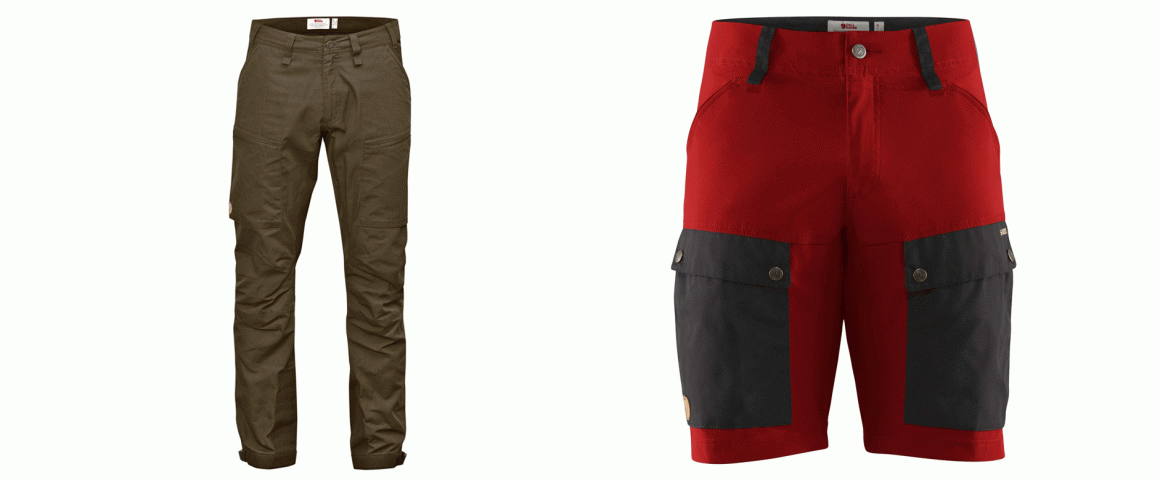For Swedish outdoor brand, Fjällräven, that product is the Kånken backpack. It’d be tough to wander through any hipster hangout without seeing that little Arctic fox staring back at you from the back of a brightly coloured Kånken pack.
And while the millions of Kånkens sold worldwide are undoubtedly helping the company’s bottom line, the reality is Fjällräven is a serious and bona fide outdoor company. The few pieces of gear from them I’ve tested over recent years are right up there in terms of technical capability, durability and construction.
During my most recent trip into Central Australia—for a couple of days of off trail hiking through unforgiving terrain—I tested two different pieces of Fjällräven kit: a pair of Keb shorts; and a pair of Abikso Lite Trekking trousers.
Not content with offering just one style of long pants with different configurations, Fjällräven instead have a range of different styles of trousers, each designed for specific environments and specific activities. Many of these styles are designed to cater freezing and wet weather—not surprising given Fjällräven’s home in Scandinavia. But of course, those conditions aren’t frequently experienced in much of Australia. When I chatted to the folk at Fjällräven and where I was going as “hot, spinifex and rocky” they suggested the lighter-weight, well ventilated Abikso trousers (also available as shorts) and the more durable Keb shorts (also available as trousers).
Both share common design elements. These include Fjällräven’s proprietary polyester-cotton blend G-1000 fabric. G-1000 is the foundation of many of Fjällräven’s products, from packs to jackets to trousers. A hardwearing and ventilating fabric, the fabric is further enhanced (water resistance and durability) when coated with Fjällräven’s Greenland Wax. The Abikso uses the G-1000 for the entire front panels, around the calves and rear panels, whereas the Keb shorts just use G-1000 as front pocket panels and across the rear. The remainder of both pants are made from an elasticated and highly stretchable fabric. This makes the back of both pants not only breathable but also comfortable. And for added breathability, Abisko trousers have zips down the upper thigh that can be opened up.
A combination of zippered and buttoned pockets ensures security for some items and quicker access to others. Neither pants have rear pockets, an intentional design feature to avoid sitting on stuff; I think it’s a good idea. Both pants also have hanging loops on the front belt straps, and while a belt can also be worn, I found I didn’t need to wear one for either pair.
The Abiskos—which are reinforced and include a tightening strap—also have a design feature I’d never seen before: a hidden hook in the bottom hem with which to latch onto shoelaces holding down your pants. It’s clear Fjällräven’s design team have thought hard about the functionality of their garments.
All this unsurprisingly, comes at a premium. Neither the Keb or the Abisko could be described as cheap. Or even light, for that matter. But are they functional? Yes. As good as it gets. You can’t ask for more of your clothing than to perform flawlessly in the conditions they are being worn in. And for me, in Central Australia, that meant withstanding constant rubbing against jagged and sharp rocks, protection from the spinifex, while all the time maintaining breathability in the near 40°C temperatures we found ourselves in. This is not easy to achieve. So yes, while the Keb shorts and Abisko trousers are on the pricier side, they’re also garments that are at the pinnacle of outerwear. If you’ve got the funds, it’s hard to do better.
Review: R.Handel
Need to know:
Fjallraven Abisko Lite Trekking Trousers
Intended use: Trekking in warm conditions
Weight: 480g (size AU 38-39)
Material: G-1000 Lite and G-1000 HeavyDuty
RRP: $319.95
Fjallraven Keb Shorts
Intended use: Trekking in warm conditions
Weight: 400g (size AU 38-39)
Material: G-1000 Eco
RRP: $199.95
More info: www.fjallraven.com.au


